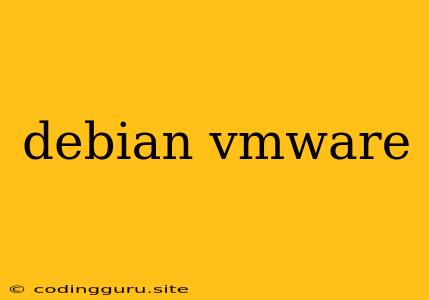Running Debian on VMware: A Comprehensive Guide
Setting up a Debian virtual machine (VM) on VMware Workstation or VMware Player is a common practice for developers, system administrators, and anyone who wants to experiment with the Debian operating system without affecting their main system. It allows you to test new software, configure servers, or simply learn the intricacies of the Debian environment in a safe and isolated environment.
This guide will walk you through the process of creating and configuring a Debian VM on VMware, addressing common challenges and providing tips for a smooth experience.
1. Preparing Your Environment
Before you begin, ensure you have the following:
- VMware Workstation or Player: Download and install the appropriate version of VMware for your operating system.
- Debian ISO Image: Download the latest Debian ISO image from the official Debian website.
- Sufficient Disk Space: Allocate enough disk space for your VM.
- Internet Connection: You will need an internet connection to download the Debian ISO and update your VM.
2. Creating the Debian Virtual Machine
Open VMware Workstation or Player and follow these steps:
- Create a New Virtual Machine: Select "Create a New Virtual Machine" from the "File" menu.
- Select "Custom (advanced)": Choose the "Custom (advanced)" option to have greater control over the VM's configuration.
- Select "I will install the operating system later": Since you already have the Debian ISO, select this option.
- Choose the Operating System: Select "Linux" and then "Debian" as the operating system.
- Specify the Disk Space: Set the desired disk size for your VM. Consider the applications and data you plan to store on it.
- Customize Hardware Settings: Adjust the virtual machine's hardware specifications as needed. You can modify the CPU cores, RAM, network adapter, and other settings.
- Connect the Debian ISO: In the "Settings" window, locate the "CD/DVD (SATA)" option and browse to the location of your Debian ISO file.
3. Installing Debian
Once your VM is ready, start it and follow these steps to install Debian:
- Boot from the Debian ISO: The VM should automatically boot from the ISO.
- Choose Installation Options: Select your language, keyboard layout, and network settings.
- Install Debian: Choose the "Guided - install the entire system" option for a basic installation.
- Configure Network: Configure the network connection. You can use DHCP for automatic IP address assignment or manually configure the network settings.
- Set Root Password: Create a strong password for the root user.
- Partition Disk Space: You can choose to automatically partition your hard drive or manually configure the partitions.
- Complete Installation: The installation process will continue and install the basic Debian system files.
- Reboot: After the installation completes, reboot your VM to start using Debian.
4. Post-Installation Configuration
After installing Debian, you'll need to perform some essential configurations:
- Update System: Use the following commands to update the system packages:
sudo apt update sudo apt upgrade - Install Essential Tools: Install common tools and applications:
sudo apt install vim nano git curl wget - Configure Network: Configure the network settings according to your needs.
- Install Graphical Environment (Optional): If you want a graphical user interface, install a desktop environment like GNOME or KDE:
sudo apt install gnome-desktop - Configure SSH (Optional): If you want to access the VM remotely, install and configure SSH:
Remember to create a user account and set a password.sudo apt install openssh-server
5. Troubleshooting Common Issues
Here are some common problems you might encounter and their solutions:
- VM not starting: Make sure the VM is powered on and the CD/DVD drive is configured to use the Debian ISO.
- Installation fails: Try booting from the ISO in BIOS mode if UEFI mode is causing issues.
- Network connection problems: Ensure the network adapter settings are correct in the VM configuration.
- Error messages: Consult online resources for specific error messages. Search for the error code and look for solutions provided by the Debian community.
6. Optimizing VM Performance
To improve the performance of your Debian VM, consider these tips:
- Allocate More RAM: Increase the RAM allocated to the VM to ensure sufficient resources.
- Use a Faster Hard Drive: If possible, connect the VM to a faster hard drive, like an SSD, for faster disk operations.
- Adjust CPU Cores: Assign more CPU cores to the VM if you require high performance.
- Disable Unnecessary Services: Disable services that you don't need to reduce resource consumption.
- Use a Lightweight Desktop Environment: If you are using a graphical environment, consider using a lightweight desktop environment like Xfce or LXDE instead of heavier options like GNOME or KDE.
Conclusion
Running Debian on VMware provides a flexible and controlled environment for development, testing, and learning. By following this guide, you can create a Debian VM, install the necessary software, and optimize its performance for your specific needs. Remember to consult official documentation and online resources for troubleshooting and advanced configurations.
